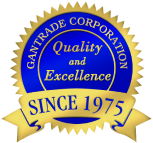
GAA (glacial acrylic acid) means the acrylic acid monomer contains only a low amount of water and freezes at 13°C (55°F). Glacial acrylic acid is typically min. 99.0 % pure with a water content less than 0.3%. Deionized water is sometimes added to acrylic acid to reduce its freezing point for some applications. However, the use of deionized water increases the dimerization rate of the acrylic acid and reduces the solubility of oxygen, which is needed for inhibition. Acrylic acid-water mixtures should be quickly used after preparation. GAA can be stable for up to one year from the date of manufacture if stored properly.
Gantrade sells Glacial Acrylic Acid in 450 lb drums and in tank trucks, with the following specifications:
Item Specifications
Appearance at 25 °C: Clear, colorless liquid
Purity by GC, % > 99.0
Color, APHA < 10
Moisture weight % by K.F. < 0.20
Inhibitor Concentration,
ppm MEHQ 180 – 220
Please reference Gantrade’s SDS on GAA monomer.
Glacial acrylic acid (GAA) can rapidly homopolymerize and is highly reactive with a wide variety of chemicals. GAA will readily polymerize if not properly inhibited, so it is important to give attention to the proper inhibition, handling, storage and use of GAA to avoid dangerous conditions. GAA is generally inhibited with hydroquinone monomethyl ether (MEHQ, methoxyphenol); when properly inhibited GAA is normally stable for up to one-year from the manufacturing date, if stored and handled under recommended conditions. However, even when properly inhibited, polymerization can occur due to freezing-thawing cycles, which affects the proper distribution of the inhibitor, and by contamination or excessive heat. A partial listing of Incompatible materials include peroxy-compounds, metal salts, metals susceptible to corrosion, oxidizing agents, acids and bases. See the reference below for a more complete listing.
In addition, the head space over GAA needs to be blanked with an atmosphere that contains 5-21% oxygen, since dissolved oxygen is necessary for MEHQ to function effectively. GAA is not flammable in air at ambient temperatures, thus air is acceptable as a blanket atmosphere. Never use an inert atmosphere like pure nitrogen with GAA. Uncontrolled polymerization is rapid and can be violent, generating large amounts of heat which increases the pressure in a drum or storage tank. This increase in pressure can cause the release of hot vapor of GAA.
The freezing point of GAA is 13°C (55°F); storage temperatures should be maintained at 15 to 25°C (59 to 77°F) at all times. Freezing (or partially freezing) of GAA must be avoided because the crystallized GAA excludes the MEHQ and the solid GAA will contain a deficiency of inhibitor and oxygen. The MEHQ will concentrate in any remaining liquid phase. Thawing GAA can be extremely hazardous if not conducted properly. Conditions during thawing, such as localized areas of heat, may cause rapid polymerization. The use of tempered water tracing, heated or insulated containers, controlled temperature storage areas and heated transportation trucks are recommended to prevent freezing in cold temperatures. Steam or electric heating bands should not be used to heat or thaw GAA because temperatures above 45°C (113°F) can lead to runaway polymerizations. The temperature of the medium used to thaw acrylic acid should never be greater than 35-45°C (95-113°F). During thawing, the GAA should be mixed to redistribute the inhibitor and resupply dissolved oxygen. Do not remove GAA from storage facilities or drums until after the thawing and redistribution of the inhibitor and dissolved oxygen has been fully completed.
Drums of frozen acrylic acid should be thawed in a heated room at temperatures between 20 and 33°C (68 and 91°F). Drum rollers, pallet shakers or tote agitators can be used to periodically agitate drums during thawing to redistribute the inhibitor and dissolved oxygen. Properly thawed drums should then be maintained at 15 to 25°C (59 to 77°F).
For more explicit procedures for thawing GAA, please refer to the following industrial brochure Acrylic Acid Safety and Handling Guide. Learn more on the overview page: Glacial Acrylic Acid
GAA slowly dimerizes upon standing to form diacrylic acid. This is an ionic mechanism called a Michael-type addition reaction. While this dimer forming reaction has a slow rate and is not hazardous, diacrylic acid can affect the performance of the GAA at high concentrations by interfering with the free radical polymerization process. No inhibitors are known for retarding or preventing the dimerization process. The rate of dimer formation is temperature dependent. After one month at 30˚C (85˚F), about 1.2% dimer is formed. For longer time periods or higher temperatures, higher levels of dimer will be formed.

For additional information on the dimerization of GAA, see the brochure Acrylic Acid Safety and Handling Guide.
As noted above, acrylic acid dimerizes to diacrylic acid during storage. The diacrylic acid can affect the performance of the GAA at high concentrations by interfering with the free radical polymerization process. After one month at 30˚C (85˚F), about 1.2% dimer is formed. For longer time periods or higher temperatures, higher levels of dimer will be formed.

